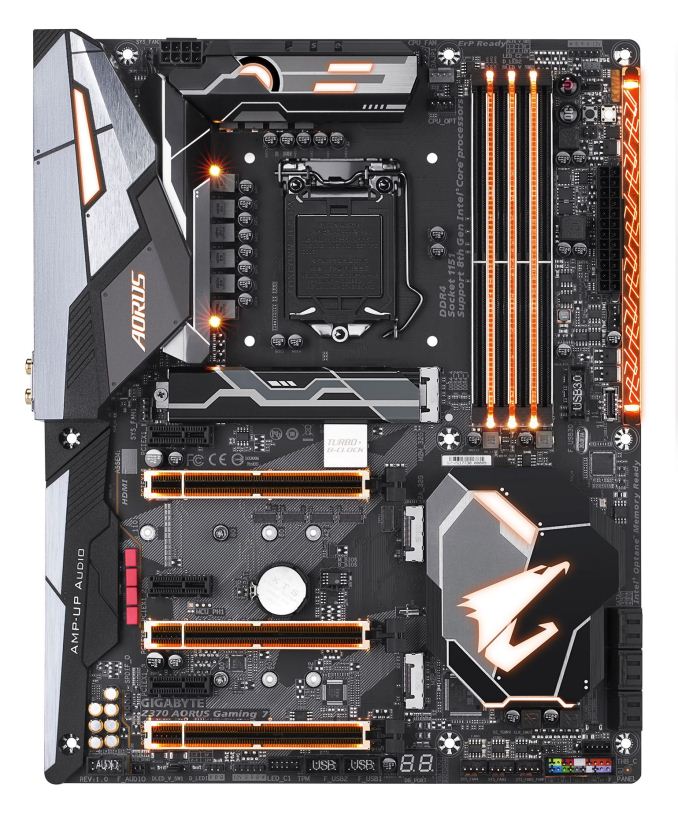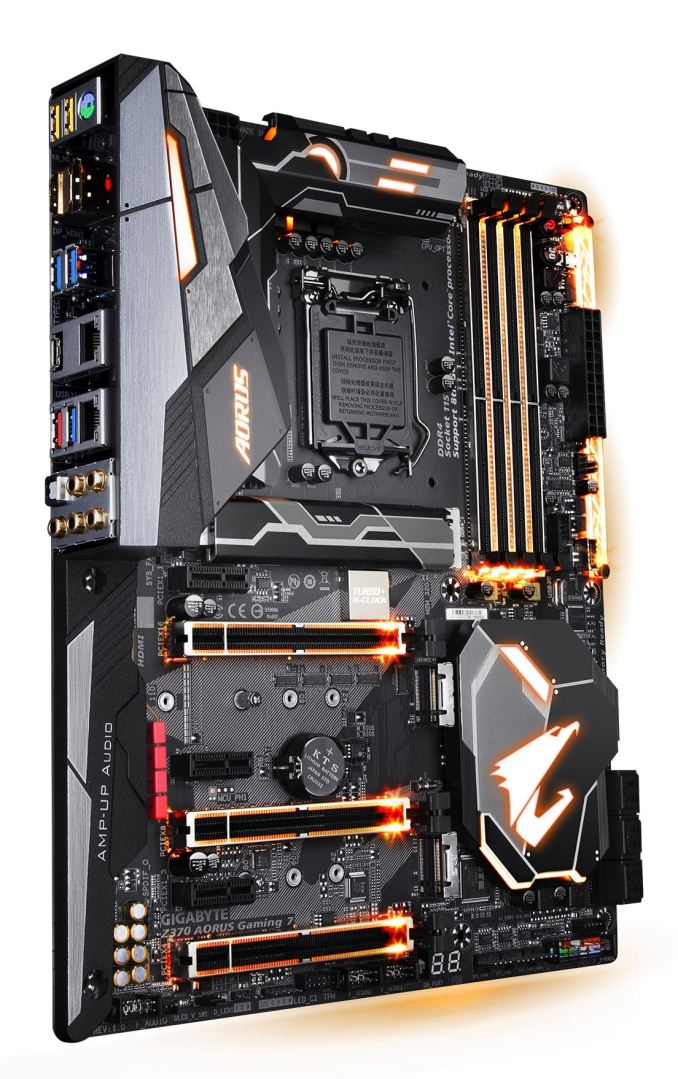Analyzing Z370 for Intel's 8th Generation Coffee Lake: A Quick Look at 50+ Motherboards
by Ian Cutress, Anton Shilov, Joe Shields & Gavin Bonshor on October 20, 2017 2:00 PM ESTGIGABYTE AORUS is starting off its entrance into the Z370 chipset with a total of nine offerings. The 'entry level' Ultra Durable lineup has three boards: the Z370XP SLI, HD3P, and HD3. The AORUS Gaming lineup has the other six boards, offering more features and glamor than the UD boards. From the flagship down there is the Gaming 7, Gaming 5, Ultra Gaming, Gaming 3, Gaming K3, and Gaming Wi-Fi. Each board will offer slightly features from a different VRM section, the number of M.2 connections, USB, networking, audio codecs, and more.
GIGABYTE Z370 Gaming 7
The AORUS Gaming 7 looks to be the brightest (literally) board of the bunch with RGB LEDs found in several places on the board: the IO cover, the VRM heatsink, by the VRMs on the board, between the DIMM slots, on the PCIe slots, the PCH heatsink, and finally, an aesthetic strip on the right side by the 24-pin ATX connector.
All of the full-length PCIe slots have steel reinforcement to prevent slot damage against heavy video cards. The Gaming 7 is the only board in the lineup to add power/reset and overclocking buttons on the PCB which are located in the upper right-hand corner. The Gaming 7 uses different chokes for the VRM from Coiltronics (FP 1007) - from the pictures provided, we are unable to tell if the MOSFETs or controller is different to the Gaming 5. For more BCLK range and flexibility for overclocking, there is a BCLK generator under the EMI shield between the top M.2 and PCIe slots.
The Gaming 7 uses of four reinforced DIMM slots with RGB LEDs in between. capable of up to 64GB of system memory. The supported memory speeds for the Gaming 7 (and Gaming 5) are the highest in the GIGABYTE lineup at DDR4-4133. The other boards will top out at DDR4-4000 by comparison. The PCIe slot locations allow for triple wide video cards to be used in a Dual GPU setup and are wired in an x16/x8/x4 configuration with the last slot powered by the chipset, meaning two-way SLI and three-way Crossfire are supported. PCIe x1 slots are located above the first, second, and last full-length PCIe slots and are fed from the chipset. The last PCIe slot shares bandwidth with the M2P_32G and will operate at up to 2x mode when using a PCIe SSD in that specific slot.
For SATA storage, we will see a pretty familiar theme across the entire lineup as each board will have six SATA ports. In the case of the Gaming 7, they are located to the right of the chipset heatsink and set at a right angle to the board. The three M.2 slots can be found just above the first PCIe x1 slot, below the first full-length slot, as well as the second. The top M.2 slot comes with a heatsink and will fit up to a 110mm device, while the other two slots support up to 80mm drives and do not come with a heatsink.
For users that connect chassis and system fans to the board directly, the Gaming 7 has a total of eight fan headers: the CPU fan and CPU_Opt are located by the socket between the DIMM slots and the VRM heatsink; Across the bottom are three system fan headers with a fourth hiding at the end of the top M.2 slot behind the rear I/O audio; the eighth fan header is located in the top right corner of the board. All headers are hybrid and can be controlled by PWM or voltage using the RGB Fusion software.
Audio is driven by the Realtek ALC1220 codec and uses an ESS Sabre DAC, Nichicon caps, and WIMA audio caps in an effort to improve headphone output. The Gaming 7 has dual NICs, using the Rivet Networks Killer E2500 controller alongside the Intel I219V. There is no Wi-Fi, which is perhaps an interesting omission on a flagship board - however the Gaming 5 does have WiFi. Thunderbolt 3 connectivity is maintained on the Gaming 7 with the header located in the bottom right-hand corner above the front panel headers.
USB support is a bit different here than the other GIGABYTE boards. The Gaming 7 has USB3.1 (10 Gbps) Type-C and Type-A headers on the rear I/O but also add a Type-C header for the front. USB3.1 (5 Gbps) shows a header for the front and five ports on the rear. The rear I/O is a bit more sparse without Wi-Fi, but it still includes Displayport and HDMI outputs for video, the two NICs, five USB 5 Gbps Type-A ports, and the two USB 3.1 (10 Gbps) ports (Type-A and Type-C).
The Gaming 7 comes with everything most users need including a lot of RGB LEDs and adds features such as a reinforced third PCIe slot, a Killer E2500 NIC, onboard Power/Reset/OC buttons, and improved headphone audio. About the only thing missing is Wi-Fi which could also be added via an add-in card.
| GIGABYTE Z370 AORUS Gaming 7 | |
| Warranty Period | 3 Years |
| Product Page | Link |
| Price | Amazon US |
| Size | ATX |
| CPU Interface | LGA1151 |
| Chipset | Intel Z370 Express |
| Memory Slots (DDR4) | Four DDR4 Supporting 64GB Dual Channel Support DDR4 4133+ Support for ECC UDIMM (operates in non-ECC mode) |
| Network Connectivity | 1 x Rivet Networks Killer E2500 LAN 1 x Intel GbE LAN |
| Onboard Audio | Realtek ALC1220 |
| PCIe Slots for Graphics (from CPU) | 1 x PCIe 3.0 x16 slots @ x16 or x8 1 x PCIe 3.0 x16 slots @ x8 |
| PCIe Slots for Other (from Chipset) | 1 x PCIe 3.0 x16 slots @ x4 3 x PCIe 3.0 x1 slots @ x1 |
| Onboard SATA | 6 x Supporting RAID 0/1/5/10 |
| Onboard SATA Express | None |
| Onboard M.2 | 3 x PCIe 3.0 x4 - NVMe or SATA |
| Onboard U.2 | None |
| USB 3.1 (10 Gbps) | 1 x Type-C (ASMedia) 1 x Type-A (ASMedia) 1 x Type-C (ASMedia - through internal header) |
| USB 3.1 (5 Gbps) aka USB 3.0 |
5 x Back Panel 1 x Header |
| USB 2.0 | 2 x Headers |
| Power Connectors | 1 x 24-pin EATX 1 x 8-pin ATX 12V 1 x 4-pin ATX 12V |
| Fan Headers | 1 x CPU 1 x Watercooling CPU 5 x System Fan headers 1 x 3A System Fan/ Water Pump header |
| IO Panel | 1 x PS.2 keyboard/mouse port 1 x DisplayPort 1 x HDMI Port 5 x USB 3.1 ports 1 x USB 3.1 Type-C 1 x USB 3.1 Type-A 2 x RJ-45 LAN Port 1 x Optical S/PDIF out 5 x Audio Jacks |













83 Comments
View All Comments
weevilone - Wednesday, October 25, 2017 - link
Notable that though the new boards are often very similar to their Z270 predecessors, Asus has dropped Thunderbolt 3 support from the Maximus X Hero board.masouth - Thursday, October 26, 2017 - link
ASUS ROG Z370 Maximus X Hero"....new metallic heat sinks that are an upgrade over the plastic heatsinks found on the Z270 version"
Please excuse my ignorance because I didn't own a ROG Z270 mb but...plastic HEAT SINKS? Not shrouds or decoration over a heat sink but the actual heat sinks themselves? That's either wrong, they performed their job pretty poorly, or plastic resins have advanced a lot farther in thermal conductivity (and cost for such) than I realized.
flowrush - Sunday, November 19, 2017 - link
"The other main distinguishable feature is the inclusion of integrated 802.11ac Wi-Fi with an antenna (that can only be described as a shark fin) found on the F."The above is incorrect in the article. The integrated Wi-Fi module with antenna is found on the E not the F.
Coldgame - Saturday, November 25, 2017 - link
I'm looking to build a rig with the Z370 Gaming ITX/ac, a GTX-1070 card and an Apple Thunderbolt Display.The review states:
"The key difference in the support between the two boards is going to be the Thunderbolt 3 port on the Gaming-ITX. This port supports video outputs..."
So, can anyone confirm or deny that video generated by the GTX-1070 can be output through the onboard Thunderbolt 3 port?
hanselltc - Sunday, December 3, 2017 - link
Looking forward to low-middle end mITX choices from this platform. It'll probably be paired with a 8100/8300 and be my secondary machine.Roen - Sunday, February 4, 2018 - link
Where are the 10 Gbps ports on the back? They all look like 5 Gbps ports, even the Type C.rbarak - Wednesday, February 21, 2018 - link
Is anyone using the Z370-P on Linux with two screens?I built a new machine based on the Z370-P, and both the DVI and the HDMI connected screens show the same image, and the RHEL7 setup/displays show only one Unknown Display.
I follwed the advice on stackexchange, and added this line:
$ grep GRUB_CMDLINE_LINE_DEFAULT /etc/default/grub
GRUB_CMDLINE_LINE_DEFAULT="i915.alpha_support=1"
Then I did:
sudo grub2-mkconfig -o "$(readlink /etc/grub2.conf)"
And rebooted, but still, the two displays are not shown.
dromoxen - Wednesday, May 9, 2018 - link
Shocked to see that both the Asrock mitx boards are "szie=ATX" .. LOLThe addition of Tunderbolt sure seems to add a hefty premium £120 vs £160 , luckily I can do without.
Kroebo - Sunday, October 7, 2018 - link
Sadly, I discovered that the ZUG Gaming PLUS doesn't support SLI.trag - Tuesday, January 15, 2019 - link
On the ASrock Z370M Pro4 the M.2 slot information is backwards. Both slots support NVME. One slot also supports SATA. As written, "The first M.2 slot is SATA only while the second supports PCIe." it seems to say that one slot is SATA only and the other slot is PCIe (NVME) only.